Related Research Articles

Kannauj is a city, administrative headquarters and a municipal board or Nagar Palika Parishad in Kannauj district in the Indian state of Uttar Pradesh. The city's name is an evolved form of the classical name Kanyakubja. It was also known as Mahodaya during the time of Mihira Bhoja. It is situated 104 kilometres west of the state capital, Lucknow.

Harshavardhana was the Emperor of Kannauj of the Pushyabhuti dynasty who ruled northern India from year 606 to 647 CE. He was the son of Prabhakaravardhana who had defeated the Alchon Hun invaders, and the younger brother of Rajyavardhana, the previous king of Thanesar, present-day Haryana.

Shashanka was the first independent king of a unified polity in the Bengal region, called the Gauda Kingdom. He reigned in the 7th century, some historians place his rule between circa 600 CE and 636/7 CE, whereas other sources place his reign between 590 and 625 CE.
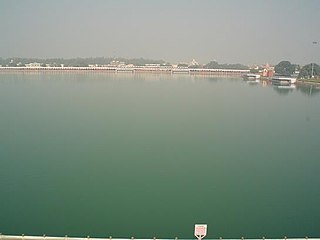
Thanesar is a historic city and Hindu pilgrimage centre in the Kurukshetra district of Haryana, India. It is located approximately 160 km northwest of Delhi. The city Kurukshetra's area merges with Thanesar.
Bāṇabhaṭṭa was a 7th-century Sanskrit prose writer and poet from India. He was the Asthana Kavi in the court of the Emperor Harsha, who reigned c. 606–647 CE in northern India, first from Sthanvishvara, and later Kanyakubja. Bāna's principal works include a biography of Harsha, the Harshacharita, and one of the world's earliest novels, Kadambari. Bāṇa died before finishing the novel and it was completed by his son Bhūṣaṇabhaṭṭa. Both these works are noted texts of Sanskrit literature. The other works attributed to him are the Caṇḍikāśataka and a drama, the Pārvatīpariṇaya. Banabhatta gets an applause as "Banochhistam Jagatsarvam" meaning Bana has described everything in this world and nothing is left.
Pulakeshin II popularly known as Immaḍi Pulakeśi, was the greatest Chalukyan Emperor who reigned from Vatapi. During his reign, the Chalukya Empire expanded to cover most of the Deccan region in peninsular India.

The Maukhari dynasty was a post-Gupta dynasty who controlled the vast plains of Ganga-Yamuna for over six generations from their capital at Kanyakubja. Maukharis were Kshatriyas who belonged to the Chandravamsha or the Lunar race. They earlier served as vassals of the Guptas and later of Harsha's Vardhana dynasty. The Maukharis established their independence during the mid 6th century. The dynasty ruled over much of Uttar Pradesh and Magadha. Around 606 CE, a large area of their empire was reconquered by the Later Guptas. According to Hieun-Tsang, the territory may have been lost to King Shashanka of the Gauda Kingdom, who declared independence circa 600CE.
The Harshacharita, is the biography of Indian emperor Harsha by Banabhatta, also known as Bana, who was a Sanskrit writer of seventh-century CE India. He was the Asthana Kavi, meaning Court Poet, of Harsha. The Harshacharita was the first composition of Bana and is considered to be the beginning of writing of historical poetic works in the Sanskrit language.
The Malavas or Malwas were an ancient Indian tribe. Modern scholars identify them with the Mallian people (Malloi) who were settled in the Punjab region at the time of Alexander's invasion in the 4th century BCE. Later, the Malavas migrated southwards to present-day Rajasthan, and ultimately to Madhya Pradesh and Gujarat. Their power gradually declined as a result of defeats against the Western Satraps, the Gupta emperor Samudragupta, and the Chalukya emperor Pulakeshin II.
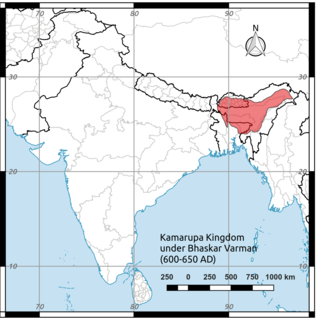
Bhaskaravarman was king of medieval Kamarupa and the last of the Varman dynasty. After being captured by the Gauda king during the reign of his father, he was able to re-establish the rule of the Varmans. He made political alliances with Harshavardhana of Thaneswar, against the alliance of the Gauda and East Malwa. He was visited by Xuanzang and Wang Xuance, the envoys of the Tang dynasty who have left accounts of the king and the kingdom.
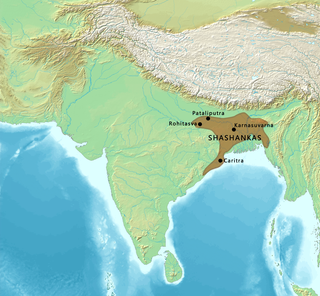
The Gauḍa Kingdom, was a classic kingdom during the Classical period on the Indian subcontinent, which originated in the Gauda region of Bengal in 4th century CE or possibly earlier.
Grahavarman was a king of Kannauj around the early seventh-century CE. He came from the Maukhari dynasty and succeeded his father, Avantivarman. Grahavarman married Rajyashri, the daughter of the ruler of Thanesar, Prabhakar Vardhana. The marriage appears to have been an alliance of the two dynasties against the king of the Malavas.
Prabhakaravardhana was a king of Thanesar in northern India around the time of the decline of the Gupta Empire. According to the historian R. C. Majumdar, he was the first notable king of the Vardhana dynasty but the fourth ruler from the family, who are also referred to as the Pushpabhutis. He had been preceded by his father, Adityavardhana, grandfather Rajyavardhana I and great-grandfather, Naravardhana, but inscriptions suggest that Banabhatta, the seventh-century bard and chronicler of the Vardhanas, may have been wrong to call these earlier rulers kings and that they may instead have been mere feudatory rulers of minor significance.
Gurjaradesa or Gurjaratra is a historical region in India comprising the eastern Rajasthan and northern Gujarat during the period of 6th–12th century CE. The predominant power of the region, the Gurjara-Pratiharas eventually controlled a major part of North India centered at Kannauj. The modern state of "Gujarat" derives its name from the ancient Gurjaratra.
The origin of the Gurjara-Pratihara dynasty of India is a topic of debate among historians. The rulers of this dynasty used the self-designation "Pratihara" for their clan, but have been described as "Gurjara" by their neighbouring kingdoms. Only one particular inscription of a feudatory ruler named Mathanadeva mentions him as a "Gurjara-Pratihara".

The Pushyabhuti dynasty, also known as the Vardhana dynasty, was the ruling dynasty of the Kingdom of Thanesar and the Kannauj Empire in northern India during the 6th and 7th centuries. The dynasty reached its zenith under its last ruler Harsha Vardhana, whose empire covered much of north and north-western India, extending till Kamarupa in the east and Narmada River in the south. The dynasty initially ruled from Sthanveshvara, but Harsha eventually made Kanyakubja his capital, from where he ruled until 647 CE.
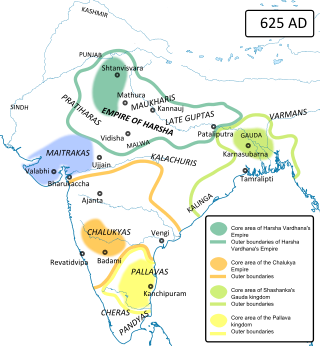
The Later Gupta dynasty ruled Magadha in eastern India between the 6th and 8th centuries CE. The Later Guptas succeeded the Imperial Guptas as the rulers of eastern Malwa or Magadha, but there is no evidence connecting the two dynasties; these appear to be two distinct families. The "Later Guptas" are so-called because the names of their rulers ended with the suffix "-gupta", which they might have adopted to portray themselves as the successors of the Imperial Guptas.
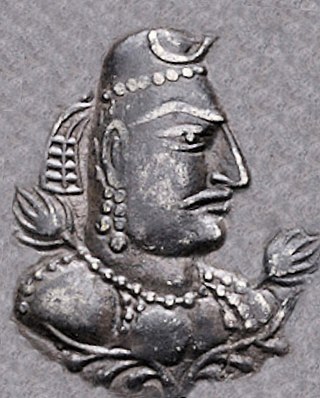
The Alchon Huns, also known as the Alkhan, Alchono, Alxon, Alkhon, Alakhana, and Walxon, were a nomadic people who established states in Central Asia and South Asia during the 4th and 6th centuries CE. They were first mentioned as being located in Paropamisus, and later expanded south-east, into the Punjab and Central India, as far as Eran and Kausambi. The Alchon invasion of the Indian subcontinent eradicated the Kidarite Huns who had preceded them by about a century, and contributed to the fall of the Gupta Empire, in a sense bringing an end to Classical India.
Yasomati was an ancient Indian queen as the chief wife of King Prabhakaravardhana of Thanesar.
The Second Hunnic War commenced with Mihirakula's ascension to power in West Punjab around 515 AD, succeeding his father, Toramana. Initially, Mihirakula's authority seemed lesser compared to his father's, as indicated by numismatic evidence. In 520, Song Yun encountered the "King of the Huns" along the Jhelum River, where the Northern Wei envoy depicted him as having a violent demeanor and being responsible for massacres, resulting in an unpleasant meeting.
References
Citations
- 1 2 3 4 Majumdar (1977), pp. 249–251
- 1 2 3 4 5 6 7 Roy (2013), pp. 21–22
- ↑ Allan, Haig & Dodwell (1934), p. 105
- ↑ Sengupta (2011), p. 35
Bibliography
- Allan, J.; Haig, T. Wolseley; Dodwell, H. H., eds. (1934), The Cambridge Shorter History of India, Cambridge University Press
- Majumdar, Ramesh Chandra (1977) [1952], Ancient India (Reprinted ed.), Motilal Banarsidass, ISBN 978-8-12080-436-4
- Roy, Kaushik (2013), "Bana", in Coetzee, Daniel; Eysturlid, Lee W. (eds.), Philosophers of War: The Evolution of History's Greatest Military Thinkers, ABC-CLIO, ISBN 978-0-313-07033-4
- Sengupta, Nitish K. (2011), Land of Two Rivers: A History of Bengal from the Mahabharata to Mujib, Penguin Books India, ISBN 978-0-14341-678-4